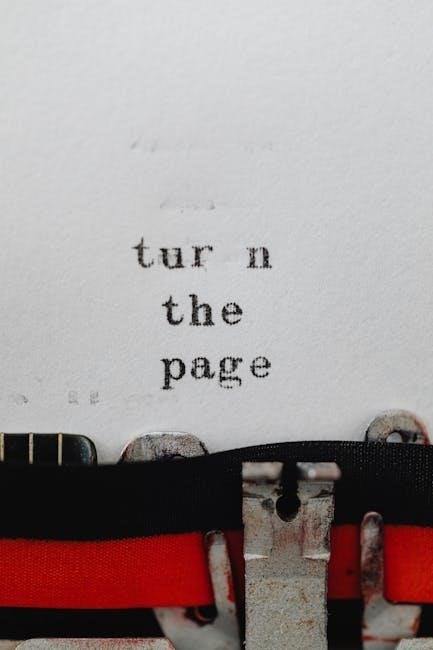The Story of an Hour PDF is a famous short story written by Kate Chopin, first published in Vogue on December 6, 1894, as The Dream of an Hour, now available online freely always.
Background Information on the Story
The story of an hour pdf is a short story that has been widely read and studied, it was written by Kate Chopin, an American author, and first published in 1894. The story is about a woman who suffers from a heart condition and is told that her husband has died in a railroad accident. The news of his death brings her a sense of freedom and joy, but ultimately leads to her own death. The story explores themes of marriage, identity, and the social conventions that restrict women’s lives. It is considered one of Chopin’s most famous works and is still widely read and studied today. The story is known for its unique narrative structure and its exploration of the human psyche. The story of an hour pdf is available online and can be downloaded for free from various websites. Many readers find the story to be a powerful commentary on the societal norms of the time.
Publication History of the Story
The story of an hour pdf was first published in Vogue on December 6, 1894, under the title The Dream of an Hour. It was later reprinted in St. Louis Life on January 5, 1895, as The Story of an Hour. The story has since been published in various anthologies and collections of Chopin’s work. The publication history of the story is notable for its initial appearance in a popular magazine, which helped to establish Chopin’s reputation as a writer. The story has been widely anthologized and is now considered a classic of American literature. The publication of the story in various forms has made it accessible to a wide range of readers. The story of an hour pdf is now available online, allowing readers to access the story from anywhere in the world. This has helped to increase its popularity and readership.

Plot and Character Analysis
Analysis of the story reveals a complex plot with deep character insights always unfolding slowly online.
Main Character and Plot Development
The main character, Louise Mallard, is a woman with a heart condition, whose life is changed when she receives news of her husband’s death. The plot develops as Louise reacts to this news, and her character is revealed through her thoughts and feelings. The story explores Louise’s inner world, showing her emotions and desires, and how she begins to see a new future for herself. As the plot unfolds, Louise’s character is developed, and her transformation is revealed. The story is a character-driven narrative, and Louise’s development is the central focus. The plot is structured to show Louise’s growth and change, and her character is revealed through her interactions with others and her inner thoughts. The story is a classic example of character development, and Louise’s transformation is a powerful and moving portrayal of a woman’s journey towards independence and self-discovery, with a lasting impact on readers.
Psychological Insight into the Protagonist
The protagonist, Louise Mallard, undergoes a significant psychological transformation, revealing her inner world and emotions. Her thoughts and feelings are expertly woven throughout the story, providing insight into her mental state. The news of her husband’s death triggers a mix of emotions, from grief to liberation, showcasing her complex psychological landscape. Through her inner monologue, the reader gains a deeper understanding of Louise’s desires, fears, and motivations. The story offers a profound psychological exploration of a woman’s experience, delving into themes of identity, autonomy, and self-discovery. The protagonist’s psychological journey is a pivotal aspect of the narrative, allowing readers to connect with her on a deeper level and understand the intricacies of her mind, making the story a compelling and thought-provoking read, with a lasting impact on the reader’s understanding of human psychology and behavior.

Themes and Symbolism in the Story
Exploring freedom and identity themes in the story deeply always online.
Themes of Freedom and Identity
The themes of freedom and identity are central to the story, as the protagonist Louise Mallard experiences a sense of liberation upon hearing of her husband’s death.
The story explores the idea of freedom as a double-edged sword, bringing both joy and terror to the protagonist.
The theme of identity is also closely tied to the idea of freedom, as Louise Mallard struggles to reconcile her old life with her newfound sense of self.
Through Louise’s journey, the story raises important questions about the nature of identity and how it is shaped by societal expectations and personal experiences.
The exploration of these themes is a key aspect of the story, and is developed through the protagonist’s inner turmoil and ultimate transformation.
The story’s portrayal of freedom and identity continues to resonate with readers today, making it a timeless and thought-provoking work of literature.
Symbols and Motifs in the Story

The story features several symbols and motifs that add depth and meaning to the narrative, including the open window, which represents freedom and escape.
The heart trouble that afflicts Louise Mallard is also a symbol, representing the oppressive nature of her marriage and societal expectations.
The character of Louise Mallard herself can be seen as a symbol of the repressed woman, struggling to find her place in a patriarchal society.
The story’s use of symbolism and motifs helps to convey the themes of freedom and identity, and adds complexity to the narrative.
The symbols and motifs are carefully woven throughout the story, creating a rich and layered texture that rewards close reading and interpretation.
The use of these literary devices helps to make the story a powerful and enduring work of literature, continuing to resonate with readers today.

Adaptations and Interpretations
The story has been adapted into films and stage plays, offering new interpretations of the narrative, exploring themes and characters, always freely available online now.
Film Adaptation of the Story
The film adaptation of The Story of an Hour was aired on PBS in 1984, titled The Joy that Kills, offering a unique interpretation of Kate Chopin’s work, exploring the complexities of the protagonist’s emotions and experiences. This adaptation brought the story to a wider audience, allowing viewers to visually connect with the narrative and its themes. The film’s title, The Joy that Kills, hints at the irony and tragedy that unfolds in the story, as the protagonist’s newfound sense of freedom ultimately leads to her demise. The adaptation stays true to the original story, capturing the essence of Chopin’s writing and the emotional depth of the characters, making it a significant contribution to the story’s legacy and a valuable resource for those interested in the story of hour pdf. The film’s impact has been notable, sparking discussions and debates about the story’s meaning and significance.
Critical Interpretations of the Story
Critical interpretations of The Story of an Hour have been varied and diverse, with scholars analyzing the narrative from different perspectives, including feminist, psychological, and literary criticism. The story has been seen as a commentary on the societal norms and expectations of women during the late 19th century, with Louise Mallard’s character representing the repressed desires and aspirations of women. Some critics have also explored the themes of identity, autonomy, and mortality in the story, highlighting the complexities of human experience and the fragility of life. The story’s ambiguous ending has been subject to multiple interpretations, with some readers seeing it as a tragic conclusion and others as a liberating moment, sparking ongoing debates and discussions about the story’s meaning and significance, making it a rich and thought-provoking work that continues to inspire critical analysis and reflection. The story remains widely studied.



